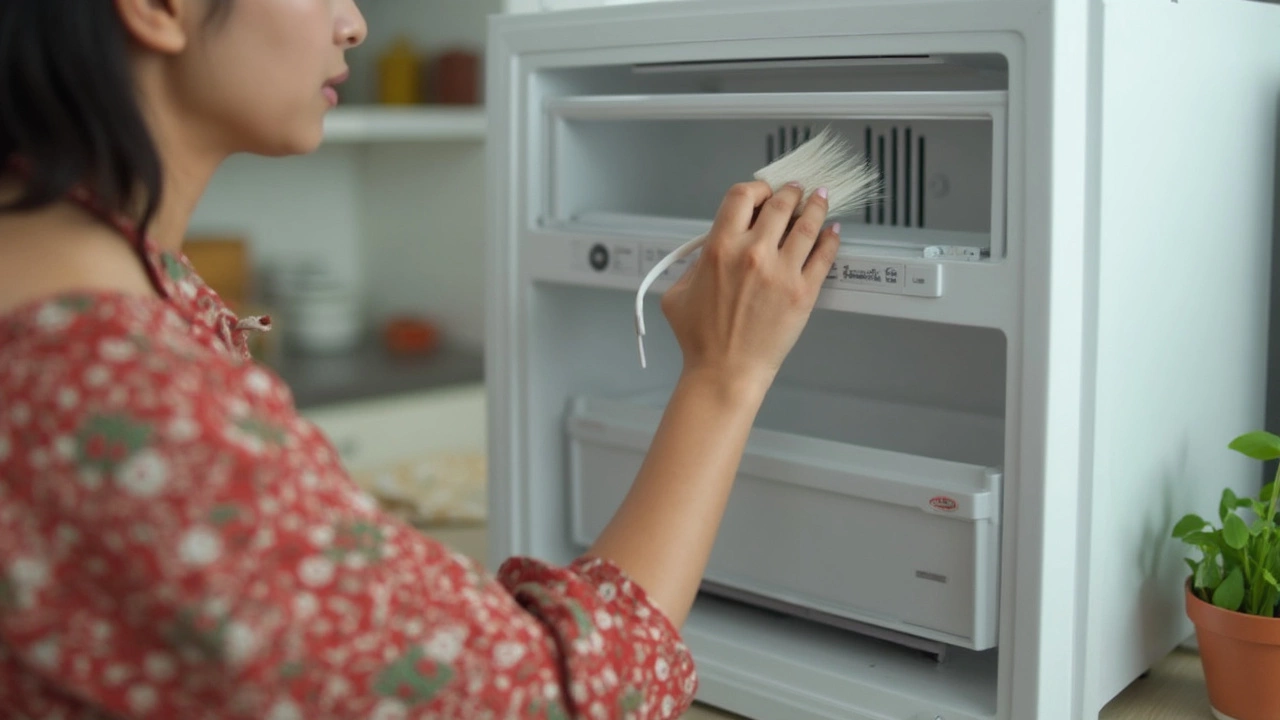
Did you know your fridge could be the reason your power bill is sneaking up every month? Keeping your refrigerator energy efficient doesn’t take a lot of money or an engineering degree—just a few tweaks here and there. For a start, check your fridge’s temperature. Most folks never touch those dials, but the sweet spot is between 37°F (3°C) and 40°F (5°C) for the fridge and 0°F (-18°C) for the freezer. Any colder and you’re just wasting power.
It sounds basic, but don’t jam your fridge full. Air needs to circulate, or the appliance will work overtime keeping everything cold. If you’re like me and stock the freezer with treats for Max and Luna, it helps to spread things out a bit instead of piling them high. Plus, keeping your most-used items up front means you won’t stand there with the door open, which is a huge energy waster.
- Right Temperature Settings
- Smart Organizing Hacks
- Seal & Gasket Checks
- Proper Placement Matters
- Maintenance That Pays Off
- Upgrading: Is It Time?
Right Temperature Settings
If you want a more energy-efficient fridge, start with the temperature controls. Sounds simple, but it’s one of the easiest ways to cut power use. The ideal fridge temp is between 37°F and 40°F (3°C–5°C). For your freezer, aim for 0°F (–18°C). Setting it any lower doesn’t keep things fresher; it just burns extra electricity and bumps up your bill.
Most folks don’t realize older fridges can drift out of whack, even if the dial says otherwise. An appliance thermometer costs just a few bucks and tells you if you’re really in the safe zone. If you haven’t checked in a while, odds are your fridge might be running cooler than needed.
- Fridge too warm? Food spoils faster and you end up tossing groceries.
- Fridge too cold? You’re paying for more cooling than you really need.
Here’s what the numbers actually mean in real life:
| Fridge Temp | Result | Energy Use |
|---|---|---|
| Above 40°F (5°C) | Food safety risk | Low |
| 37-40°F (3-5°C) | Food safe & fresh | Optimal |
| Below 36°F (2°C) | Freezing fresh food, wasted energy | High |
Double-check your settings every few months. Sometimes, Max bumps the dial when he sniffs around. And if your fridge has electronic controls, don’t rely on the preset icons—they’re often too cold by default. Adjust as needed and you’ll see a change in both your food life and your electricity bill. It really is that straightforward.
Smart Organizing Hacks
If your fridge looks like a game of Tetris gone wrong, it’s definitely using more energy than it should. Good organization goes beyond just neatness—it helps cold air move around, keeps food fresher, and cuts down on wasted electricity. Want your energy-efficient fridge to run smoother? Here’s how to organize it the smart way.
- Don’t overload the fridge. It’s tempting to squeeze in that extra pizza box, but overcrowding means cold air can’t circulate. If too packed, your fridge’s motor has to keep chugging to cool hot spots.
- Keep food in the right zones. The top shelf is warmer, so use it for leftovers, cooked foods, or drinks. Store raw meat and dairy on lower shelves where it’s coldest. This keeps food safe and avoids constant cooling cycles when temps get out of whack.
- Avoid blocking the vents. Every fridge has vents that push cold air around. If you block them with big bags or containers, certain spots get too warm, and your appliance will work overtime.
- Group similar items together. This isn’t just about looking tidy. When you know where things are, you grab what you need quicker, meaning the door stays open for less time.
- Don’t put hot food straight in. Let leftovers cool on the counter before loading the fridge. Warm dishes hike up the internal temperature and force the motor to suck up more power.
| Family Member | Estimated Time (minutes) |
|---|---|
| Adult | 5 |
| Teen | 10 |
| Child | 15 |
Those extra minutes with the door open? They add up—research from the U.S. Department of Energy shows the fridge uses up to 7% more energy every time you linger. Try putting snacks and drinks in easy-to-reach bins so everyone in the house, including forgetful teens and snack-hunting kids, spends less time searching. The less time the door is open, the less your fridge has to recover lost cold, which saves money and keeps your food safe.
Seal & Gasket Checks
This might sound nitpicky, but fridge doors that don’t seal tight are one of the top reasons for wasted energy at home. The rubber strip running around your fridge and freezer doors is called a gasket. If it cracks, gets dirty, or loses its grip, your refrigerator has to work harder, using more electricity and sometimes never really reaching the right temperature.
Here’s a quick trick: close the fridge door on a piece of paper or a dollar bill. If you can slide it out easily, the gasket isn't sealing well. Do this check at several spots around the door, not just one.
- Wipe the gaskets clean with warm, soapy water every now and then. Buildup from food or dog hair (thanks, Max) can mess up the seal.
- If your gasket is cracked, crusty, or brittle, they’re easy to replace and you don’t need special tools. Most big hardware stores carry them, or you can order one to match your fridge model online.
- Press the new gasket firmly into place, and double-check the fit—an uneven seal is just as bad as a broken one.
Making sure the door seals tight is such a simple fix, but it has a big impact on your energy-efficient fridge mission. Less cold air escaping means fewer cycles, lower power bills, and less wear on your appliance.

Proper Placement Matters
Where you put your fridge makes a big difference to how much energy it uses. Ever noticed how hot the side panels get sometimes? That’s your fridge fighting harder if it’s squeezed next to your stove or getting blasted by the afternoon sun through the kitchen window. Heat sources nearby force your fridge to run longer cycles, burning more electricity.
"Keeping a refrigerator away from heat sources can reduce its energy use by up to 40%." – U.S. Department of Energy
The best spot is somewhere cool and ventilated. Leave at least a couple of inches between the fridge and the wall, both at the back and on the sides. This gap lets heat escape instead of building up, so your fridge doesn't have to sweat it out.
High humidity is also a hidden enemy. If your kitchen is stuffy or super humid, your fridge’s compressor works overtime just to keep moisture levels down. Cramped corners with little airflow can also trap heat and drive up energy costs.
- Never put your fridge right next to ovens, dishwashers, or big sunny windows.
- Aim for at least 2 inches of clearance behind and at least 1 inch at the sides.
- If you can, put the fridge on a level surface so the doors shut tight every time. My dog Max once managed to nudge our fridge, and the door stayed a little open—cue spoiled groceries and wasted electricity.
Here’s a quick look at how placement affects energy use:
| Fridge Location | Estimated Energy Use |
|---|---|
| Next to Oven/Dishwasher | +25% higher |
| In Direct Sunlight | +30% higher |
| Properly Ventilated, Cool Area | Baseline (best) |
So, if you want to squeeze more savings out of your energy-efficient fridge, start by making sure it’s parked in the right spot. These changes take a minute to set up but can save you a chunk of change on your power bill over time.
Maintenance That Pays Off
If you want your fridge running top-notch and saving energy, regular maintenance is non-negotiable. Most people don’t realize that a dusty condenser coil can crank up the fridge’s power needs by 25%. Those coils—usually hiding behind or underneath the fridge—collect pet hair (shout-out to Max and Luna), dust, and kitchen grime. If you give them a quick vacuum or brush-down every six months, your fridge won’t have to work so hard, and your energy use will dip.
Another biggie is defrosting. Even though lots of fridges are frost-free now, older models can build up a layer of ice that forces the fridge to run longer cycles. A half-inch of frost can drop efficiency by almost 30%. If you see frost buildup, unplug, empty it out, and let things thaw. It beats paying a higher bill all year.
Keep an eye on your fridge’s door seals. If they’re cracked or not sealing tight, cold air escapes and warm air gets in, so the compressor kicks on way more than needed. Test this by closing the door on a dollar bill. If it pulls out easily, the gasket probably needs replacing. They aren’t pricey but can save you a bundle over time.
- Clean condenser coils twice a year
- Check and replace door gaskets as needed
- Defrost your fridge if you spot frost buildup
- Make sure the fridge sits level—doors won’t seal right if it’s not
Don’t forget the back or bottom drip pan. Old water sitting around not only smells gross, but it can make the fridge work harder if it ends up evaporating inside. Give it a quick rinse when you do the coils.
| Maintenance Task | Skipping = % More Power Used |
|---|---|
| Dirty Coils | +25% |
| Frost Buildup (0.5 inch) | +30% |
| Leaky Door Gasket | +15% |
Treat these bits of maintenance like oil changes for your car—easy, quick, and they help your energy-efficient fridge stay that way for years.
Upgrading: Is It Time?
Sometimes, even if you do everything right, your old fridge just isn't pulling its weight. If your refrigerator is over 10 or 15 years old, it's probably guzzling way more electricity than you think. Brands started making more energy-efficient fridges around 2010, so any model older than that is seriously behind the curve.
According to the U.S. Department of Energy, a fridge made before 1999 can use twice the energy of a modern Energy Star-rated one. That adds up fast—some folks save more than $100 a year just by swapping out an old clunker. If your fridge is running all the time, has trouble holding a steady temperature, or you notice condensation inside, it might be past its prime.
Not sure whether it’s worth the upgrade? Here’s a quick checklist:
- Your fridge is older than 15 years
- It's not Energy Star rated
- The motor runs almost constantly
- There’s frost buildup or water pooling inside
- Your electricity bills have slowly crept up
If you tick off even two of these, looking into a newer model could make life easier—and cheaper. When shopping for a replacement, skip the fancy extras like built-in screens or ice makers unless you really need them. Some gadgets use extra power or are prone to breaking down.
Also, pay attention to fridge size. Unless you have a huge family, you probably don’t need a massive fridge. Larger fridges almost always use more electricity, even if they’re newer models. Go for a size that fits your usual shopping habits, not just what looks good in the kitchen.
One more thing: If you do upgrade, recycle the old fridge properly. Most city recycling centers have special programs to make sure the coolants and parts don’t end up in a landfill. That way, you’re not just cutting costs—you’re doing right by the planet too.